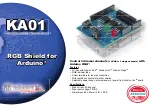
10 October 2016
5
3.2 Activation
1. Insert the SIM card
2. Connect the DC power source to the Z4550 and power up
3. Connect a computer to the Z4550 using an Ethernet cable, a browser, and the default administrative IP address
4. On the Provisioning/Radio Update screen verify that the radio firmware is correct for the network you are using
5. If the firmware is correct, proceed to section 3.4, else see section 3.3
3.3 Installing Radio Network Specific Firmware
1. On the Provisioning/Radio Update screen, select the correct firmware for the network you are using
2. Press the Update Radio button – This process will take between 2 and 3 minutes to complete
3. The SVC and Link LEDs will begin an alternating green pattern
4. The Status button on the Radio Update screen will display the network firmware that is being loaded
5. After a 2 – 3 minute delay the Status button will indicate that the radio programming has completed
6. The LEDs will simultaneously blink green indicating that the programming was successful
7. If the programming step encountered a problem the LEDs will simultaneously blink red/yellow
8. Restart or power cycle the unit
3.4 APN Selection and Account Provisioning
Important Note
– For the purposes of this manual, we divide the carriers (network operators) into two groups,
legacy CDMA carriers, e.g. Sprint and Verizon, and the legacy GSM group, which is comprised of all other networks. In
terms of provisioning the wireless account, especially APNs, these two groups present very different behaviors.
Legacy CDMA carriers use an over-the-air provisioning mechanism to “push” the appropriate APNs and settings to the
radio module when it connects to the network. Under normal operation, this process is automatic and there should be
no need to manually configure an APN. Legacy CDMA carriers currently use APN profile configuration (slot) 3 for the
operational APN.
Legacy GSM carriers do not use an over-the-air provisioning mechanism. You must enter the carrier provided APN in
APN profile configuration (slot) 1. Some legacy GSM carriers may also require you to enter a User Name, Password, and
authentication type along with the APN.
For Legacy CDMA Carriers
After the restart performed in step 8 of section 3.3 the unit will complete its reboot cycle, provision over the air, and will
obtain an IP address from the network, and light the Link LED. This process will take between 1 and two minutes. If the
Link LED is red it indicates an LTE connection, if the Link LED is green it indicates 3G connection.
For Legacy GSM Carriers
After the restart performed in step 8 of section 3.3 the unit will complete its reboot cycle. When the unit completes its
boot cycle reconnect with a browser. On the Wireless Interfaces screen enter the APN specified by your carrier.
Optionally, you may also need to enter a User Name, Password, and select an authentication type. When the required
information has been entered perform a restart or power cycle. When the unit completes its reboot cycle it will obtain







































